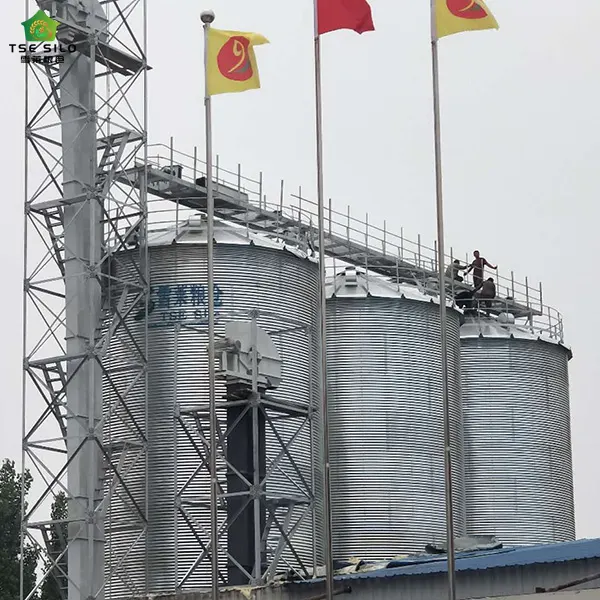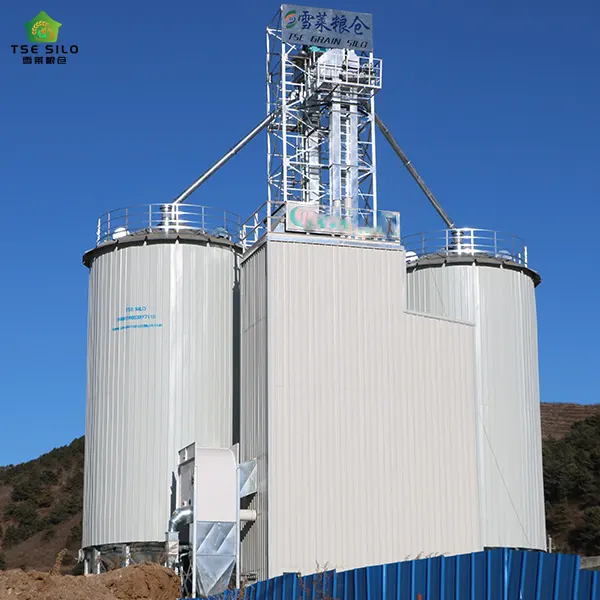


The quality acceptance of grain steel silos construction is a key link to ensure its structural safety, good sealing and service life. The acceptance should be carried out in accordance with international standards, industry specifications and design document requirements, mainly including foundation acceptance, silo acceptance, welding quality acceptance, anti-corrosion acceptance, airtightness acceptance and other aspects.
The foundation of the steel silo must be stable, and the acceptance content includes:
Check whether the foundation diameter and elevation meet the design requirements (allowable deviation ±10mm).
Foundation surface flatness (≤5mm/m²).
Whether the position, quantity and specifications of embedded parts are correct.
Concrete strength test report (C25 and above, in line with design requirements).
No cracks, honeycombs, holes and other defects.
Anchor bolt position and verticality (deviation ≤2mm).
The exposed length of the bolt meets the installation requirements.
The secondary grouting is dense and has no voids.


Check whether the steel plate material (Q235B, Q345B, etc.) meets the design requirements and check the corresponding factory inspection report.
Measure the thickness of the steel plate (allowable deviation ±0.2mm).
The verticality deviation of the silo is ≤H/1000 (H is the height of the silo) and ≤30mm.
The roundness deviation of the silo is ≤D/500 (D is the diameter) and ≤20mm.
Appearance inspection: The weld is uniform, without defects such as cracks, slag inclusions, pores, and undercuts.
Non-destructive testing (UT/RT):
100% inspection of first-level welds (key stress-bearing parts).
20% of second-level welds are sampled and meet GB 50205-2020 standards.
Check whether the welding or bolt connection between the silo roof and the silo wall is firm.
There is no deformation or water accumulation on the silo roof.
Sandblasting and rust removal reach Sa2.5 level (ISO 8501-1).
No rust, oil stains, or welding slag residue.
Coating thickness detection (epoxy zinc-rich primer ≥60μm, topcoat ≥80μm).
Coating adhesion test (grid method, ≥3 levels qualified).
No problems such as missing coating, sagging, and blistering.
Use positive or negative pressure test (pressure 500-1000Pa, maintain 30min, pressure drop ≤10% qualified).
Check whether there are leaks in welds, flanges, manholes, etc.
The feeding and discharging systems operate normally without obstruction.
The temperature measurement, ventilation, and material level monitoring systems function normally.
Ladders, guardrails and other safety facilities are stable.
The construction unit shall provide the following information:
1.Material certificate (steel plate, welding material, anti-corrosion coating, etc.).
2.Welding process qualification report (WPS/PQR).
3.Non-destructive testing report (UT/RT/MT/PT).
4.Anti-corrosion testing report (coating thickness, adhesion).
5.Foundation acceptance record (concrete strength, settlement observation).
6.Completion drawing (including design changes).


| Problems | Causes | Solutions |
| Weld cracking | Improper welding process, stress concentration | Repair welding and retesting |
| Coating peeling | Incomplete surface treatment, poor painting environment | Re-sandblasting, painting |
| Bunker deformation | Installation error, uneven load | Correction or reinforcement of support |
| Foundation settlement | Insufficient foundation bearing capacity | Grouting reinforcement or load adjustment |
1. Establish a strong sense of quality and quality responsibility, instill the awareness that quality is life to all employees, carefully check the steel silo drawings, listen to the design briefing, understand the steel silo design intention, and make a scientific, rigorous and meticulous steel silo construction organization plan.
2. Quality control before steel silo construction. First of all, we must establish a quality responsibility system at all levels, clarify that the project manager is the person responsible for the quality of the project, the chief engineer is the person responsible for quality and technology, and the construction team at all levels also establish a quality responsibility system, so that each level is responsible for its own responsibility. Secondly, we must implement the quality veto power and veto any quality risks. We must carefully read, review and supervise the relevant steel silo design and survey documents. At the same time, we must form a credit constraint to encourage the construction subject to improve the quality management assurance system, promote the benign operation of the quality system, standardize the quality behavior of all subjects at all levels and links, strictly implement the internal quality management system and quality inspection control, and achieve the quality of the design and survey documents to meet the requirements of relevant laws, regulations and mandatory standards.
3. Quality control during the construction of steel silos. The first is the quality control of the raw materials of steel silos. The raw materials such as steel bars, bricks, cement, sand, and gravel used in steel silo projects are sent to accredited laboratories for re-testing after witnessing sampling in accordance with industry regulations. Once it is found that uninspected or unqualified materials are used in steel silo projects, the supervisor should stop it immediately. If they do not listen to the advice, they should report to the superior competent department and order them to stop construction. The second is the quality control of concealed projects. Acceptance of concealed foundation. Check whether the bearing capacity of the foundation meets the design requirements, whether there is a weak underlying layer, whether the actual geological conditions are consistent with the survey report, etc. Only after confirming that the foundation soil meets the requirements can the next process be carried out. Acceptance of concealed steel sub-project. The main thing is to reasonably set quality control points and give instructions to the person in charge of the construction unit in advance. If the acceptance is not qualified, it is not allowed to be concealed. Acceptance of foundation structure and main structure. Before the foundation and main structure projects are concealed, the technical person in charge of the relevant units should be organized to conduct acceptance. After confirming that the brick masonry assembly method is correct, the gray beam fullness is >80%, the structural brick masonry mortar test block test pressure strength meets the design requirements, the concrete is defect-free and the concrete strength reaches the design strength grade, it can be concealed.
4. Quality control after the construction of steel silo. The quality supervision and management after the construction of steel silo is the supervision and management of the construction project. First of all, it is necessary to ensure that projects that do not meet the quality standards cannot be put into use to avoid direct harm and impact of inferior civil engineering projects on society and public users. Secondly, the quality supervision of steel silo repair and maintenance should be included in the scope of quality supervision and management of the entire life cycle of construction projects.
The quality acceptance of grain steel silos is crucial. Whether it is the acceptance of the steel structure itself or the acceptance of supporting facilities, relevant standards are required to ensure the normal operation of the silo and the safety of the grain in the silo.
Written by
Shandong Shelley Grain Steel Silo Co., Ltd
Editor Jin
www.grainstoragesilos.com
WhatsApp : +86-18653877118
Email : shelley@cnshelley.com